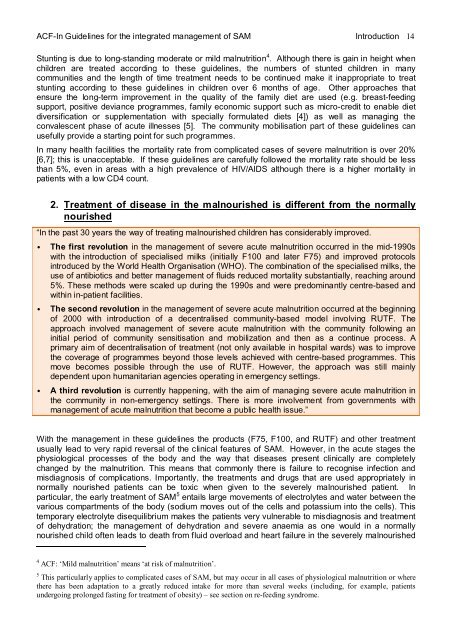guidelines for the integrated management of severe acute malnutrition
guidelines for the integrated management of severe acute malnutrition
guidelines for the integrated management of severe acute malnutrition
You also want an ePaper? Increase the reach of your titles
YUMPU automatically turns print PDFs into web optimized ePapers that Google loves.
ACF-In Guidelines <strong>for</strong> <strong>the</strong> <strong>integrated</strong> <strong>management</strong> <strong>of</strong> SAM Introduction 14<br />
Stunting is due to long-standing moderate or mild <strong>malnutrition</strong> 4 . Although <strong>the</strong>re is gain in height when<br />
children are treated according to <strong>the</strong>se <strong>guidelines</strong>, <strong>the</strong> numbers <strong>of</strong> stunted children in many<br />
communities and <strong>the</strong> length <strong>of</strong> time treatment needs to be continued make it inappropriate to treat<br />
stunting according to <strong>the</strong>se <strong>guidelines</strong> in children over 6 months <strong>of</strong> age. O<strong>the</strong>r approaches that<br />
ensure <strong>the</strong> long-term improvement in <strong>the</strong> quality <strong>of</strong> <strong>the</strong> family diet are used (e.g. breast-feeding<br />
support, positive deviance programmes, family economic support such as micro-credit to enable diet<br />
diversification or supplementation with specially <strong>for</strong>mulated diets [4]) as well as managing <strong>the</strong><br />
convalescent phase <strong>of</strong> <strong>acute</strong> illnesses [5]. The community mobilisation part <strong>of</strong> <strong>the</strong>se <strong>guidelines</strong> can<br />
usefully provide a starting point <strong>for</strong> such programmes.<br />
In many health facilities <strong>the</strong> mortality rate from complicated cases <strong>of</strong> <strong>severe</strong> <strong>malnutrition</strong> is over 20%<br />
[6,7]; this is unacceptable. If <strong>the</strong>se <strong>guidelines</strong> are carefully followed <strong>the</strong> mortality rate should be less<br />
than 5%, even in areas with a high prevalence <strong>of</strong> HIV/AIDS although <strong>the</strong>re is a higher mortality in<br />
patients with a low CD4 count.<br />
2. Treatment <strong>of</strong> disease in <strong>the</strong> malnourished is different from <strong>the</strong> normally<br />
nourished<br />
“In <strong>the</strong> past 30 years <strong>the</strong> way <strong>of</strong> treating malnourished children has considerably improved.<br />
• The first revolution in <strong>the</strong> <strong>management</strong> <strong>of</strong> <strong>severe</strong> <strong>acute</strong> <strong>malnutrition</strong> occurred in <strong>the</strong> mid-1990s<br />
with <strong>the</strong> introduction <strong>of</strong> specialised milks (initially F100 and later F75) and improved protocols<br />
introduced by <strong>the</strong> World Health Organisation (WHO). The combination <strong>of</strong> <strong>the</strong> specialised milks, <strong>the</strong><br />
use <strong>of</strong> antibiotics and better <strong>management</strong> <strong>of</strong> fluids reduced mortality substantially, reaching around<br />
5%. These methods were scaled up during <strong>the</strong> 1990s and were predominantly centre-based and<br />
within in-patient facilities.<br />
• The second revolution in <strong>the</strong> <strong>management</strong> <strong>of</strong> <strong>severe</strong> <strong>acute</strong> <strong>malnutrition</strong> occurred at <strong>the</strong> beginning<br />
<strong>of</strong> 2000 with introduction <strong>of</strong> a decentralised community-based model involving RUTF. The<br />
approach involved <strong>management</strong> <strong>of</strong> <strong>severe</strong> <strong>acute</strong> <strong>malnutrition</strong> with <strong>the</strong> community following an<br />
initial period <strong>of</strong> community sensitisation and mobilization and <strong>the</strong>n as a continue process. A<br />
primary aim <strong>of</strong> decentralisation <strong>of</strong> treatment (not only available in hospital wards) was to improve<br />
<strong>the</strong> coverage <strong>of</strong> programmes beyond those levels achieved with centre-based programmes. This<br />
move becomes possible through <strong>the</strong> use <strong>of</strong> RUTF. However, <strong>the</strong> approach was still mainly<br />
dependent upon humanitarian agencies operating in emergency settings.<br />
• A third revolution is currently happening, with <strong>the</strong> aim <strong>of</strong> managing <strong>severe</strong> <strong>acute</strong> <strong>malnutrition</strong> in<br />
<strong>the</strong> community in non-emergency settings. There is more involvement from governments with<br />
<strong>management</strong> <strong>of</strong> <strong>acute</strong> <strong>malnutrition</strong> that become a public health issue.”<br />
With <strong>the</strong> <strong>management</strong> in <strong>the</strong>se <strong>guidelines</strong> <strong>the</strong> products (F75, F100, and RUTF) and o<strong>the</strong>r treatment<br />
usually lead to very rapid reversal <strong>of</strong> <strong>the</strong> clinical features <strong>of</strong> SAM. However, in <strong>the</strong> <strong>acute</strong> stages <strong>the</strong><br />
physiological processes <strong>of</strong> <strong>the</strong> body and <strong>the</strong> way that diseases present clinically are completely<br />
changed by <strong>the</strong> <strong>malnutrition</strong>. This means that commonly <strong>the</strong>re is failure to recognise infection and<br />
misdiagnosis <strong>of</strong> complications. Importantly, <strong>the</strong> treatments and drugs that are used appropriately in<br />
normally nourished patients can be toxic when given to <strong>the</strong> <strong>severe</strong>ly malnourished patient. In<br />
particular, <strong>the</strong> early treatment <strong>of</strong> SAM 5 entails large movements <strong>of</strong> electrolytes and water between <strong>the</strong><br />
various compartments <strong>of</strong> <strong>the</strong> body (sodium moves out <strong>of</strong> <strong>the</strong> cells and potassium into <strong>the</strong> cells). This<br />
temporary electrolyte disequilibrium makes <strong>the</strong> patients very vulnerable to misdiagnosis and treatment<br />
<strong>of</strong> dehydration; <strong>the</strong> <strong>management</strong> <strong>of</strong> dehydration and <strong>severe</strong> anaemia as one would in a normally<br />
nourished child <strong>of</strong>ten leads to death from fluid overload and heart failure in <strong>the</strong> <strong>severe</strong>ly malnourished<br />
4 ACF: ‘Mild <strong>malnutrition</strong>’ means ‘at risk <strong>of</strong> <strong>malnutrition</strong>’.<br />
5 This particularly applies to complicated cases <strong>of</strong> SAM, but may occur in all cases <strong>of</strong> physiological <strong>malnutrition</strong> or where<br />
<strong>the</strong>re has been adaptation to a greatly reduced intake <strong>for</strong> more than several weeks (including, <strong>for</strong> example, patients<br />
undergoing prolonged fasting <strong>for</strong> treatment <strong>of</strong> obesity) – see section on re-feeding syndrome.

















